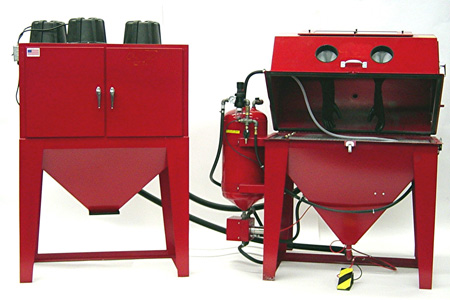Being an engine builder is like being a chef. As a master of culinary arts you may prepare the most exquisite meals anyone has ever tasted, but a great dining experience can be easily ruined if the vegetables are not thoroughly cleaned.
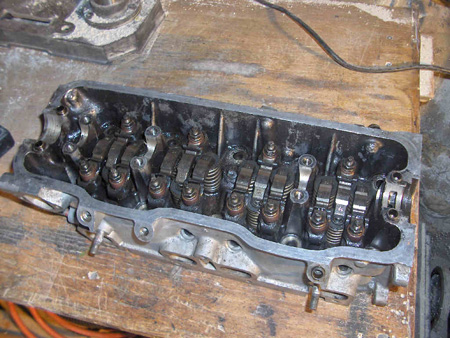
The same is true with engines. Cleaning cylinder heads may be one of the more thankless jobs your shop performs, and it often falls to the “new guy” or “the kid” to perform these tasks. However, as basic as it is, it’s a process not to be overlooked.
Whether you’re removing years of baked on sludge or cleaning a brand new cylinder head, they all must be cleaned thoroughly before being put back into service. As your mother may have told you when you were young: Cleanliness is next to Godliness. And in this case, it’s in your best interest to get the cylinder heads as clean as possible and avoid those costly comebacks or an engine failure during the big race.
Cylinder heads have many blind passages and oil galleys that make them difficult to reach for cleaning by hand, let alone with an automated cleaning system. Because of the complex casting designs, cylinder heads require a more hands-on approach to cleaning and can present challenges to a high volume production environment.
Certainly, there are considerations for thermal cleaning aluminum cylinder heads. Some engine builders say not to bake aluminum heads while others say it’s okay up to a certain point. You don’t want to expose aluminum heads to high temperatures for prolonged time periods or you might anneal (soften) the aluminum and have to start over with another head.
What it boils down to for many who do cleaning right is the right equipment, the right chemical and the right temperature at the right time.
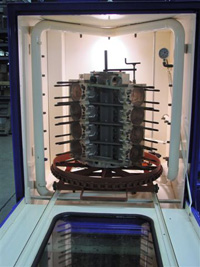
For more and more engine builders, aqueous cleaning systems are the new standard as the old VOC (volatile organic compound) solvent systems of years past are made obsolete. VOC solvents are known to contribute to smog formation and may be toxic when inhaled. Solvents evaporate quickly, making worker exposure tough to control and monitor, and legal restrictions dictate how and where you can dispose of waste.
Today there is more attention to the environment, which in turn has affected the cleaning processes engine builders use in their shops. The challenge with most aqueous systems has been to find the best combination of cost-effectiveness, low-maintenance and evirionmental-friendliness.
According the U.S. Environmental Protection Agency (EPA) aqueous cleaners contain less than 5 percent (50 grams per liter) of VOCs. These are some of the reasons aqueous cleaning has gained a solid foothold in today’s engine rebuilding facility.
According to aqueous-cleaning equipment manufacturers, water-based detergents and washer systems clean just as effectively as solvents (as long as the equipment and cleaning solutions are maintained properly). And there are many different aqueous solutions available for cleaning all types of parts including cast-iron and aluminum cylinder heads. Detergent suppliers offer many formulations that work on both aluminum and cast iron.
Manual cleaning systems are still in use today, but many shops use a water-based system instead of the old sink-on-a-drum VOC solvent system. A filtered stream of 100°-115° F aqueous cleaning solution flushes away dirt and oil as parts are cleaned with the familiar brush on the end of a hose.
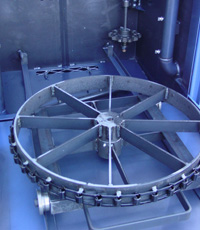
In some shops these drum and sink tanks are also being converted to bio-remediation systems. A bio-remediation system is a water-based solution that contains microbes, which are live organisms that eat oil. These live microbes break down and digest oils and other hydrocarbons, transforming grease and other gunk into water and carbon dioxide. However, the process is slow and requires maintaining the water temperature within a certain range, usually no hotter than 110° to 120° F, and replenishing the microbes regularly. This is the same principle that was used to clean up the Exxon Valdez oil tanker spill in 1999.
Immersion tanks are not as labor-intensive as the sink on drum setup. Shops have been using “hot tanks” for many years, where the cylinder head is immersed in a cleaning solution and a lift platform agitates up and down for more effectiveness. This type of system can also be used as a soak tank, which shops often use as an initial cleaning step.
In addition to a lift platform, a recirculating pump can be added to provide more turbulence to the tank. This moves the cleaning solution around in a circle inside the tank, creating additional scrubbing action. Immersion washers can be fairly effective on intricate parts such as cylinder heads and other parts with blind holes, channels, etc. The agitation process forces the cleaning solution into all the tight areas of the engine part.
A cabinet washer (often called a jet spray washer) is basically an industrial-strength dishwasher. Jet washers use a pattern of spray nozzles that spray cleaning solution with detergents under some pressure (typically 40-60 psi) onto the parts. The combination of water pressure impinging against the surface, and the secondary action of the water and detergent dispersing and rinsing away the contaminants does an effective job on most types of engine components.
In a typical jet spray washer system, the wash and rinse cycle may only take 10 to 15 minutes compared to hours of soaking in hot tank. Using jet spray washers and flow-through systems allows you to load the parts and walk away, eliminating the need for a lot of hand washing. This frees up time for other tasks such as machine work or assembly work, tasks that add more to the bottom line.
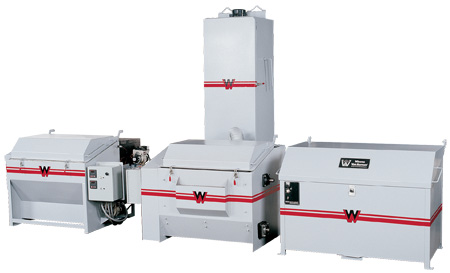
The disadvantage of the spray cabinet washer for cylinder head cleaning is one of the biggest advantages of the immersion-type washer. The jet washer’s spray pattern cleans areas it hits very well. But it can’t get into tight areas like blind holes, for example. And if it can’t get in to an area, it just won’t clean. That’s why engine builders usually have to get in and “clean behind the ears.” Cylinder heads have many tough to reach areas and most automated systems can’t reach them all.
Jet spray washers employ several nozzles around a stationary manifold system (although some part of the system usually rotates to reach more areas) to shoot water at the cylinder head(s) that are sitting on a turntable inside the washer cabinet.
High-pressure spray-booth systems operate similarly to glass bead systems and add increased cleaning capabilities over jet spray washers. They require manual operation and blast out between 400-600 psi of water pressure. This allows aqueous cleaning solution to clean parts such as cylinder heads with blind, tight areas with a high degree of impingement, meaning it will break through all the layers of crud.
Another type of cleaning system being used more and more in the automotive industry is the ultrasonic parts washer, which is very effective at removing carbon and burned on oils. The ultrasonic process is also particularly suited to cleaning blind holes and geometrically complex parts – again, well suited for cylinder head cleaning.
Ultrasonics works by using sound waves above the frequency normally considered audible for humans (above 18 Kilohertz).
When high frequency vibrations are introduced into liquids, areas of extremely high vacuum and extremely high pressure are generated alternately at any given point in the liquid as the sound waves pass. The vacuum effect creates what is called a cavitation bubble.
As positive pressure replaces the vacuum that formed the cavitation bubble, it collapses in implosion resulting in high-pressure shock waves, which does the work of scrubbing the part and pulling the debris away from the surface of the cylinder head. Energetic disturbances are generated by the implosions of countless cavitation bubbles. These perform the cleaning task by providing micro-agitation throughout the liquid volume.
